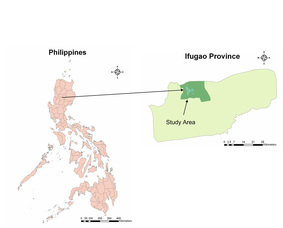Ifugao Archaeology in the news:
Manila Bulletin, July 5, 2012
Manila Times, March 30, 2012
Business World Online, July 29, 2010
Manila Bulletin, July 5, 2012
Manila Times, March 30, 2012
Business World Online, July 29, 2010
Research Interests
Summary:
My research interests and long-term goals seek to promote better understanding of Southeast Asian archaeology by applying a landscape approach to investigate relationships between agricultural production and social organization. To accomplish this objective, my current research examines the landscape and archaeology of the Ifugao (northern Philippines). Studies of agricultural intensification and emergent complexity/state formation in Southeast Asia have focused mainly on lowland populations and have largely overlooked highland societies. I intend to continue my investigations on highland agriculture and social organization by expanding the study region and incorporating numerous agricultural terracing communities in the Philippine Cordillera. Guided by a complex adaptive systems theory and a self-organizing framework, I seek to understand highland populations that practice intensified agriculture through terracing, but lack the organizational correlates of a stratified polity that were once assumed to be associated with agricultural intensification.
The Ifugao Archaeological Project:
As part of the PhD program at the University of Hawaii-Mānoa, and funded by an NSF Dissertation Improvement Grant, Henry Luce Foundation/ACLS Dissertation Fellowship for East and Southeast Asian Archaeology, and a variety of small grants, I completed a PhD Dissertation that investigated the archaeology of the Ifugao agricultural terraces. Results of these investigations provide broader anthropological implications in the study of agricultural systems – past and living. Specifically, my doctoral study combined theoretical discussions on complex adaptive systems and self-organization; methodological (Bayesian modeling) contributions to archaeology; and, application of Geographic Information Systems (GIS) in understanding the distribution of agricultural fields in the Cordillera highlands of the northern Philippines. An important contribution of this research employed a Bayesian model to establish the age of the Ifugao rice terraces, published by the journal Antiquity. My studies in Ifugao also offer important implications for understanding the impacts of European colonization to local economic practices in Southeast Asia.
As a continuation of my PhD work, the Ifugao Archaeological Project (IAP) was formally launched in the summer of 2012. The IAP is a collaborative research program among the community (through the Save the Ifugao Terraces Movement, Inc. [SITMo]), the Provincial Government of Ifugao, the National Museum of the Philippines [NM], and myself [as a research affiliate of both SITMo and NM]). The IAP hopes to address research agenda that includes:
1) Culture-historical reconstructions;
2) Documenting highland responses to climate change;
3) Theoretical contributions to social organization debates;
4) Methodological development in archaeological dating of agricultural terraces;
5) Contributions to solving contemporary problems, especially in managing/preserving
archaeological heritage sites; and,
6) An active community engagement on heritage management.
My Ifugao work utilizes the landscape approach and historical ecology framework and intends to address questions that relate to managerial requirements of intensive agricultural systems. This is a perennial topic in anthropology because of the once long-held archaeological assumption that large-scale agricultural systems are generally associated with centralized forms of political organization. Although ethnographic studies and archaeological investigations in the last few decades have shown that labor-intensive irrigation does not require politically-centralized management, the development of alternative models, however, has lagged. Thus, even though my initial Ifugao case study suggests that agricultural system complexity does not translate into political organization centrality, the precise role of water management remains unresolved, and more work is needed on the relationship between water management systems and political organization.
Addressing the question of organizational stratification vis-à-vis agricultural system requires a multi-faceted approach. Following the demonstrated strategy of my dissertation, a nuanced understanding of the role of agriculture and irrigation can be achieved by using landscape analysis through GIS, ethnography, sub-surface excavations, and lake sediment cores. Accordingly, I intend to utilize this strategy in expanding my investigations in the Philippine Cordillera in the next five years.
IAP Directions:
The IAP consists of two-phases: Phase I will take place over the course of two years and will be devoted to the expansion of the GIS database mapping the distribution of agricultural features as well as carrying out archaeological surveys and subsurface sampling in lower elevation towns. Sediment cores from an upland lake will also be obtained in this Phase to establish land cover changes and climatic shifts in the region. Phase II will run through the next three years and will concentrate on accomplishing the same objectives on interior agricultural centers (i.e. focusing on UNESCO clusters of Hungduan, Hapao, Battad, and Mayoyao). Both of these phases will be guided by the intention to investigate broader anthropological issues of agricultural intensification, water management, climate change and subsistence shifts, and political economy.
The research interests and goals that outlined above offer vital contributions to East and Southeast Asian archaeology and anthropological archaeology in general. The IAP’s investigations expand our understanding of Asian archaeology and prehistory by incorporating highland emergent complexity and agricultural intensification in the growing Asian archaeology literature. In addition, this research shows that the Ifugao case is comparable to issues that we see in other parts of the ancient and contemporary world. My research resonates with places such as Bali, other highland areas in Southeast Asia, and the Andes. Thus, my general research trajectory, although currently focused on highland Southeast Asia, is comparative and cross-cultural in its theoretical perspective.

